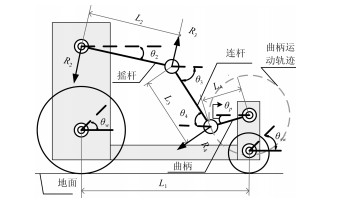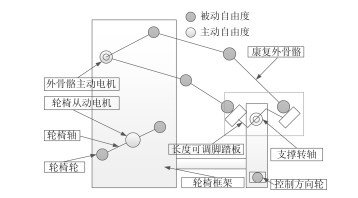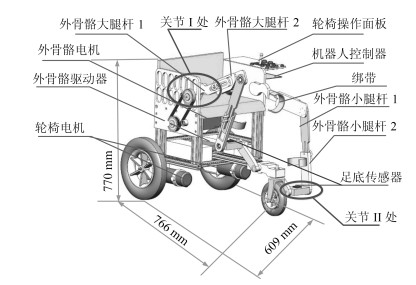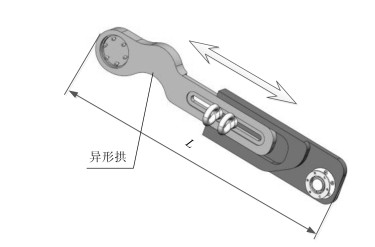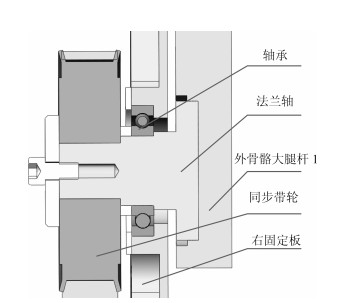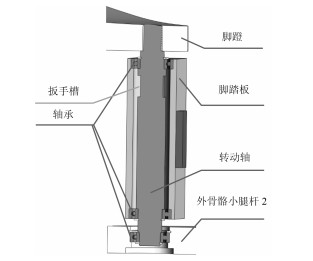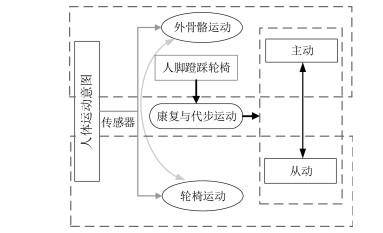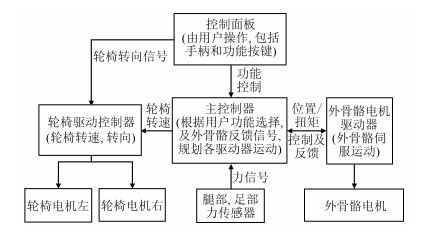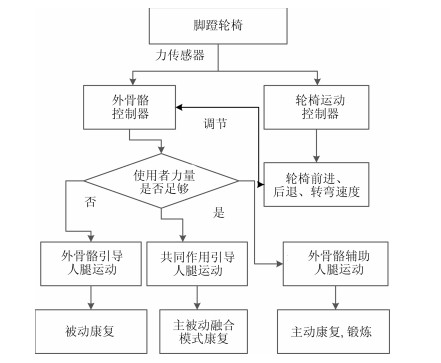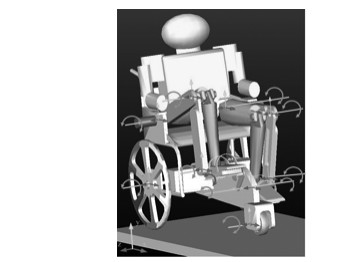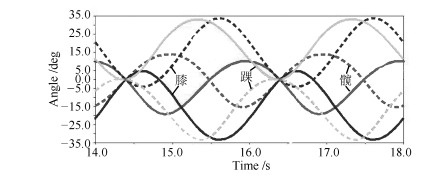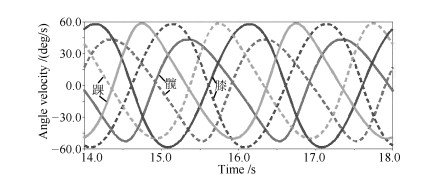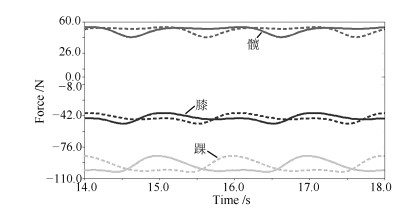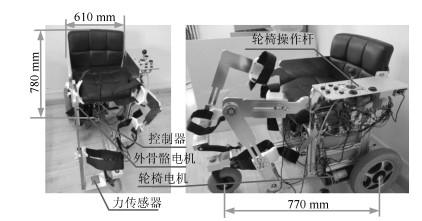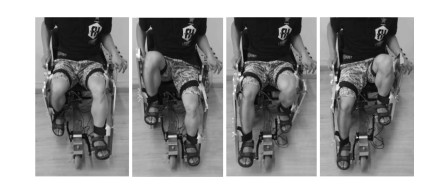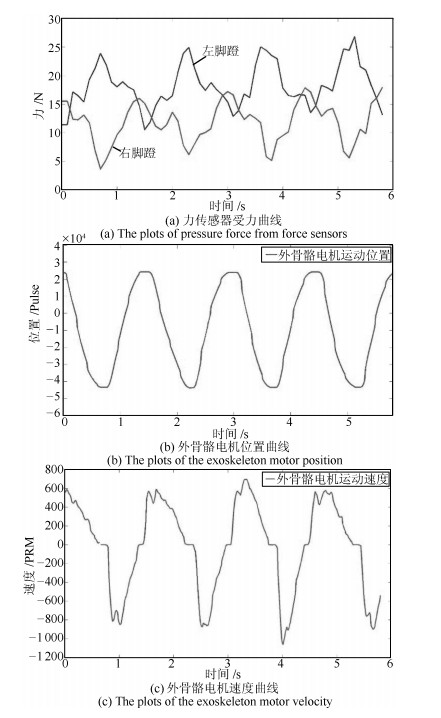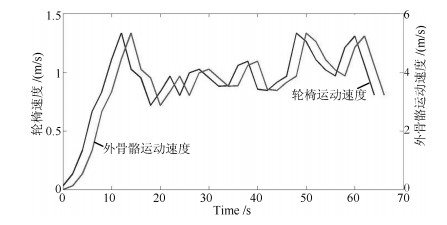-
摘要: 针对老年人及下肢障碍者康复训练与代步问题,本文提出一种新的康复与代步外骨骼机器人.本文首先详细介绍了机器人各部分组成及机构设计方案,通过下肢外骨骼与轮椅的有机结合,有效保持或恢复老年人、脑卒中患者下肢运动能力的同时,为患者提供一种方便的代步工具;运用脚蹬车运动制订康复训练策略,可保持下肢康复训练轨迹固定,保证患者安全;提出主从式操作方法及多模态康复训练控制流程提高使用者参与感.最后通过仿真与实验验证了所提康复系统的可行性与设计的正确性.Abstract: Towards the rehabilitation and training problems of older persons and lower limb disabilities, the paper proposes a new robot with lower limb exoskeleton for rehabilitation and walking assistance. The components and mechanical design of the robot are introduced in detail. Through the function combination of lower limb exoskeleton and wheelchair, the robot can help the users to maintain the lower limb movement effectively and provide them with a convenient tools for movement. The pedal-actuated motion training strategy can ensure the safety of users. The master-slave operational mode is put forward with multimodal rehabilitation training process control. Correctness and feasibility of the rehabilitation system are validated by computer simulation and experiment.
-
Key words:
- Rehabilitation robot /
- exoskeleton /
- mechanical design /
- master-slave operational flow /
- simulation
1) 本文责任编委 王启宁 -
图 11 ADAMS环境中机器人与人的模型及各旋转关节示意
Fig. 11 An ADAMS model of the design in Fig. 4 with indication of parameters
表 1 外骨骼机器人机构设计参数
Table 1 Speciflcations of the new leg-exoskeleton assisted wheelchair
设计参数 数值 自由度 2 机器人重量(kg) 55 高度(mm) 800 长度(mm) 780 宽度(mm) 609 轮椅运行速度(m/s) 1~3 θ2(°) -15~15 θ3(°) -5~35 θ4(°) 0~35 L2 (mm) 380~430 L3 (mm) 370~420 -
[1] 吴玉韶, 党俊武.老龄蓝皮书:中国老龄产业发展报告(2014).北京:社会科学文献出版社, 2014. 70-88Wu Yu-Shao, Dang Jun-Wu. Blue Book for Aging:China Report of the Development on Siliver Industry (2014). Beijing:Social Sciences Academic Press, 2014. 70-88 [2] 王陇德.中国脑卒中防治报告(2015).北京:中国协和医科大学出版社, 2015. 10-22Wang Long-De. Report on the Chinese Stroke Prevention (2015). Beijing:China Union Medical University Press, 2015. 10-22 [3] 谭民, 王硕.机器人技术研究进展.自动化学报, 2013, 39(7):963-972 http://www.aas.net.cn/CN/abstract/abstract18124.shtmlTan Min, Wang Shuo. Research progress on robotics. Acta Automatica Sinica, 2013, 39(7):963-972 http://www.aas.net.cn/CN/abstract/abstract18124.shtml [4] 周媛, 王宁华.康复机器人概述.中国康复医学杂志, 2015, 30(4):400-403 http://www.cnki.com.cn/Article/CJFDTOTAL-ZGKF201504025.htmZhou Yuan, Wang Ning-Hua. Rehabilitation robot:review. Chinese Journal of Rehabilitation Medicine, 2015, 30(4):400-403 http://www.cnki.com.cn/Article/CJFDTOTAL-ZGKF201504025.htm [5] Volpe B T, Krebs H I, Hogan N, Edelstein O T R L, Diels C, Aisen M. A novel approach to stroke rehabilitation:robot-aided sensorimotor stimulation. Neurology, 2000, 54(10):1938-1944 doi: 10.1212/WNL.54.10.1938 [6] Ju M S, Lin C C K, Lin D H, Hwang I S, Chen S M. A rehabilitation robot with force-position hybrid fuzzy controller:hybrid fuzzy control of rehabilitation robot. IEEE Transactions on Neural Systems and Rehabilitation Engineering, 2005, 13(3):349-358 doi: 10.1109/TNSRE.2005.847354 [7] 胡进, 侯增广, 陈翼雄, 张峰, 王卫群.下肢康复机器人及其交互控制方法.自动化学报, 2014, 40(11):2377-2390 http://www.aas.net.cn/CN/abstract/abstract18514.shtmlHu Jin, Hou Zeng-Guang, Chen Yi-Xiong, Zhang Feng, Wang Wei-Qun. Lower limb rehabilitation robots and interactive control methods. Acta Automatica Sinica, 2014, 40(11):2377-2390 http://www.aas.net.cn/CN/abstract/abstract18514.shtml [8] Ueda Y, Misu S, Sawa R, Nakatsu N, Sugimoto T, Sugiyama K, Takamori K, Ono K, Seki K, Handa Y, Ono R. Cycling wheelchair provides enjoyable pedaling exercises with increased physiological indexes. Tohoku Journal of Experimental Medicine, 2016, 238(1):33-38 doi: 10.1620/tjem.238.33 [9] Restorative Therapies. RT300 leg[Online], available:http://www.restorative-therapies.com/rt300leg, July 24, 2014 [10] RECK-Technical GmbH & Co KG. MOTOmed[Online], available:http://www.motomed.com/en/models.html, July 24, 2014 [11] Best K L, Routhier F, Miller W C. A description of manual wheelchair skills training:current practices in Canadian rehabilitation centers. Disability and Rehabilitation:Assistive Technology, 2015, 10(5):393-400 doi: 10.3109/17483107.2014.907367 [12] Toro M L, Garcia Y, Ojeda A M, Dausey D J, Pearlman J. Quantitative exploratory evaluation of the frequency, causes and consequences of rehabilitation wheelchair breakdowns delivered at a paediatric clinic in Mexico. Disability, CBR & Inclusive Development, 2012, 23(3):48-64 [13] 金文宇.基于UG的康复轮椅设计与仿真分析.机械, 2013, 40(12):67-69 http://www.cnki.com.cn/Article/CJFDTOTAL-MECH201312018.htmJin Wen-Yu. Design and simulation analysis of rehabilitation wheelchair based on UG. Machinery, 2013, 40(12):67-69 http://www.cnki.com.cn/Article/CJFDTOTAL-MECH201312018.htm [14] Kim K, Payne K, Oh S, Hori Y. One-handed propulsion control of power-assisted wheelchair with advanced turning mode. In:Proceedings of the 13th International Workshop on Advanced Motion Control (AMC). Yokohama, Japan:IEEE, 2014. 633-638 [15] Watanabe T, Murakami T, Handa Y. Preliminary tests of a prototype FES control system for cycling wheelchair rehabilitation. In:Proceedings of the 2013 International Conference on Rehabilitation Robotics (ICORR). Seattle, WA, USA:IEEE, 2013. 1-6 [16] Watanabe T, Karasawa Y, Handa Y. A test of controlling different muscles in FES cycling with cycling wheelchair "Profhand". In:Proceedings of the 19th International Functional Electrical Stimulation Society Annual Conference (IFESS). Kuala Lumpur, Malaysia:IEEE, 2014:1-4 [17] Karasawa Y, Watanabe T, Handa Y. A basic study on analyzing acceleration of crank rotation for evaluation of FES cycling with cycling wheelchair. Transactions of Japanese Society for Medical and Biological Engineering, 2014, 52(S):O-27-O-28 https://www.researchgate.net/publication/289722606_A_basic_study_on_analyzing_acceleration_of_crank_rotation_for_evaluation_of_FES_cycling_with_cycling_wheelchair [18] Esquenazi A, Talaty M, Packel A, Saulino M. The ReWalk powered exoskeleton to restore ambulatory function to individuals with thoracic-level motor-complete spinal cord injury. American Journal of Physical Medicine & Rehabilitation, 2012, 91(11):911-921 https://www.researchgate.net/publication/232532271_The_ReWalk_Powered_Exoskeleton_to_Restore_Ambulatory_Function_to_Individuals_with_Thoracic-Level_Motor-Complete_Spinal_Cord_Injury [19] Zeilig G, Weingarden H, Zwecker M. Safety and tolerance of the ReWalk exoskeleton suit for ambulation by people with complete spinal cord injury:a pilot study. The Journal of Spinal Cord Medicine, 2012, 35(2):96-101 doi: 10.1179/2045772312Y.0000000003 [20] Talaty M, Esquenazi A, Briceno J E. Differentiating ability in users of the ReWalk powered exoskeleton:an analysis of walking kinematics. In:Proceedings of the 2013 IEEE International Conference on Rehabilitation Robotics (ICORR). Seattle, WA, USA:IEEE, 2013. 1-5 [21] Ueba T, Hamada O, Ogata T, Inoue T, Shiota E, Sankai Y. Feasibility and safety of acute phase rehabilitation after stroke using the hybrid assistive limb robot suit. Neurologia Medico-Chirurgica, 2013, 53(5):287-290 doi: 10.2176/nmc.53.287 [22] Nilsson A, Vreede K S, Häglund V, Kawamoto H, Sankai Y, Borg J. Gait training early after stroke with a new exoskeleton-the hybrid assistive limb:a study of safety and feasibility. Journal of Neuroengineering and Rehabilitation, 2014, 11(1):1-11 doi: 10.1186/1743-0003-11-1 [23] 佟丽娜, 侯增广, 彭亮, 王卫群, 陈翼雄, 谭民.基于多路sEMG时序分析的人体运动模式识别方法.自动化学报, 2014, 40(5):810-821 http://www.aas.net.cn/CN/abstract/abstract18349.shtmlTong Li-Na, Hou Zeng-Guang, Peng Liang, Wang Wei-Qun, Chen Yi-Xiong, Tan Min. Multi-channel sEMG time series analysis based human motion recognition method. Acta Automatica Sinica, 2014, 40(5):810-821 http://www.aas.net.cn/CN/abstract/abstract18349.shtml [24] 彭亮, 侯增广, 王卫群.康复机器人的同步主动交互控制与实现.自动化学报, 2015, 41(11):1837-1846 http://www.aas.net.cn/CN/abstract/abstract18759.shtmlPeng Liang, Hou Zeng-Guang, Wang Wei-Qun. Synchronous active interaction control and its implementation for a rehabilitation robot. Acta Automatica Sinica, 2015, 41(11):1837-1846 http://www.aas.net.cn/CN/abstract/abstract18759.shtml [25] Wang H B, Shi X H, Liu H T, Li L, Hou Z G, Yu H N. Design, kinematics, simulation, and experiment for a lower-limb rehabilitation robot. Proceedings of the Institution of Mechanical Engineers, Part I:Journal of Systems and Control Engineering, 2011, 225(6):860-872 doi: 10.1177/0959651811408978 [26] Yang C J, Niu B, Chen Y. Adaptive neuro-fuzzy control based development of a wearable exoskeleton leg for human walking power augmentation. In:Proceedings of the 2005 IEEE/ASME International Conference on Advanced Intelligent Mechatronics. Monterey, CA, USA:IEEE, 2005. 467-472 [27] 姜洪源, 马长波, 陆念力, 敖宏瑞.功能性电刺激脚踏车训练系统建模及仿真分析.系统仿真学报, 2010, 22(10):2459-2463 http://www.cnki.com.cn/Article/CJFDTOTAL-XTFZ201010047.htmJiang Hong-Yuan, Ma Chang-Bo, Lu Nian-Li, Ao Hong-Rui. Modeling and simulation on FES cycling training system. Journal of System Simulation, 2010, 22(10):2459-2463 http://www.cnki.com.cn/Article/CJFDTOTAL-XTFZ201010047.htm [28] 边辉, 赵铁石, 田行斌, 李丹, 潘旺.生物融合式康复机构及其应用.机器人, 2010, 32(4):470-477 doi: 10.3724/SP.J.1218.2010.00470Bian Hui, Zhao Tie-Shi, Tian Xing-Bin, Li Dan, Pan Wang. Rehabilitation facility with biological integration and application. Robot, 2010, 32(4):470-477 doi: 10.3724/SP.J.1218.2010.00470 [29] Huang G, Ceccarelli M, Zhang W M, Liu H X, Tian Y, She H T, Fukuda T, Huang Q. A pedal-actuated wheelchair with a leg exoskeleton. In:Proceedings of the 14th IFToMM World Congress. Taipei, China:IFToMM, 2015. http://www.iftomm2015.tw/IFToMM2015CD/PDF/OS13-127.pdf [30] So R C H, Ng J K F, Ng G Y F. Muscle recruitment pattern in cycling:a review. Physical Therapy in Sport, 2005, 6(2):89-96 doi: 10.1016/j.ptsp.2005.02.004 [31] Feland J B, Myrer J W, Schulthies S S, Fellingham G W, Measom G W. The effect of duration of stretching of the hamstring muscle group for increasing range of motion in people aged 65 years or older. Physical Therapy, 2001, 81(5):1110-1117 [32] Ziegler R G, Hoover R N, Nomura A M Y, West D W, Wu A H, Pike M C, Lake A J, Horn-Ross P L, Kolonel L N, Siiteri P K, Fraumeni J F Jr. Relative weight, weight change, height, and breast cancer risk in Asian-American women. Journal of the National Cancer Institute, 1996, 88(10):650-660 doi: 10.1093/jnci/88.10.650 [33] Hawkins D, Hull M L. A method for determining lower extremity muscle-tendon lengths during flexion/extension movements. Journal of Biomechanics, 1990, 23(5):487-494 doi: 10.1016/0021-9290(90)90304-L -




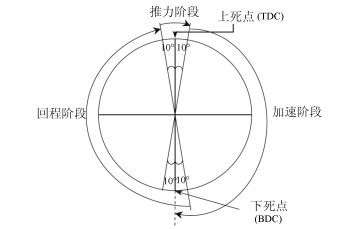
 下载:
下载:
